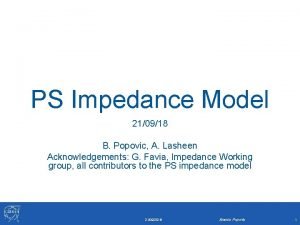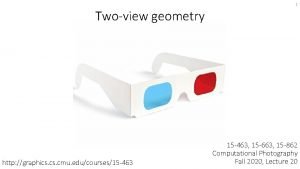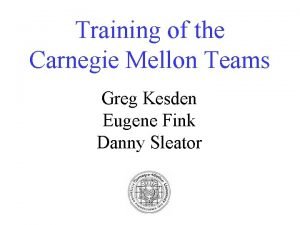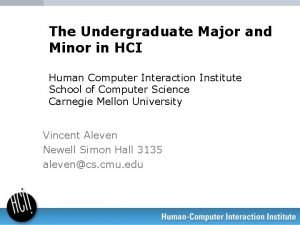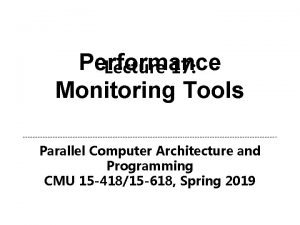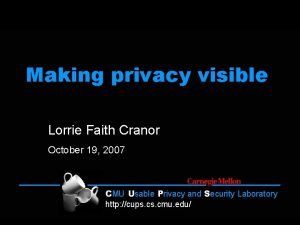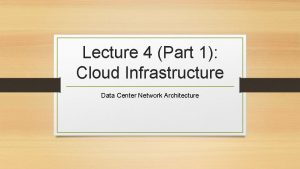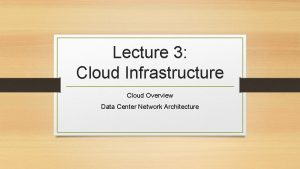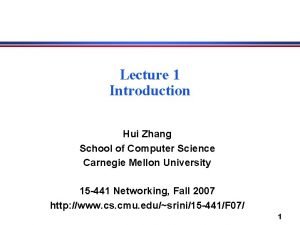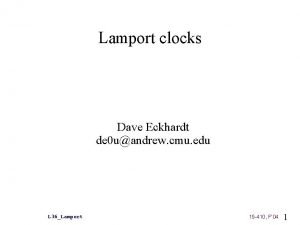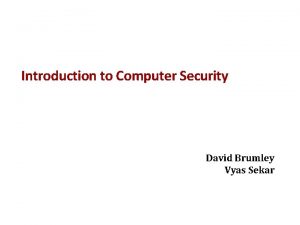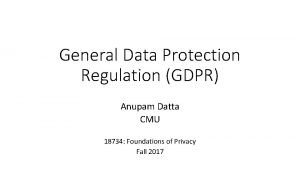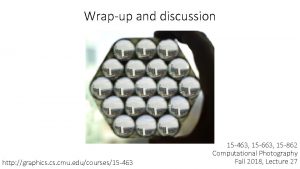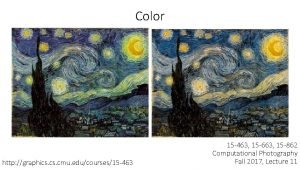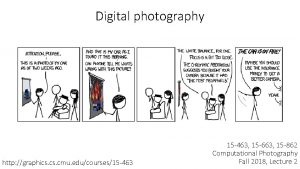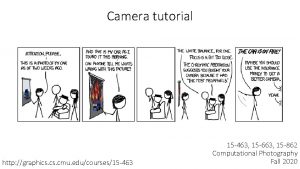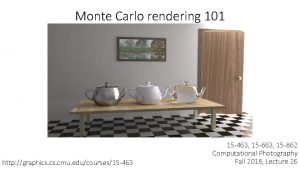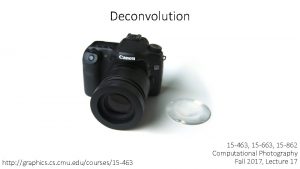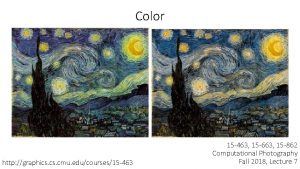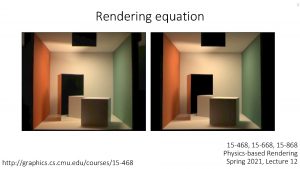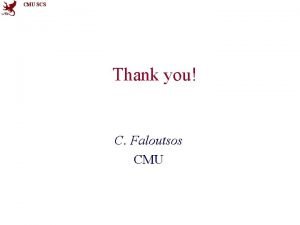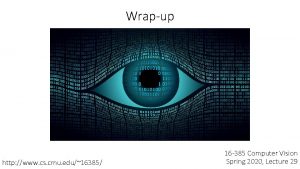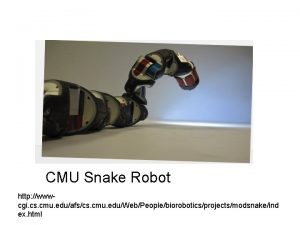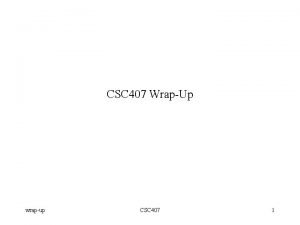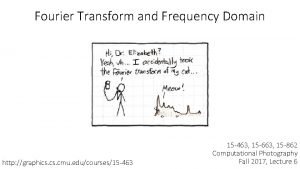1 Wrapup and discussion http graphics cmu educourses15



















- Slides: 19

1 Wrap-up and discussion http: //graphics. cmu. edu/courses/15 -463, 15 -663, 15 -862 Computational Photography Fall 2020, Lecture 26

2 Course announcements • Homework assignment 6 is due on 12/11 and optional assignment 7 is due on 12/18. - Any questions about either homework? - You can use any remaining late days for the two homeworks. • Final project presentations on Thursday 12/17. - Logistics will be posted on Piazza. • Final project reports due on Sunday 12/20, midnight. • One upcoming computational photography talk: - Tuesday 15 th, 11 am – noon, Ricardo Martin-Brualla, “Ne. RF”. • Suggest topics for Friday’s reading group on Piazza.

3 Class evaluation*s* – please take them! • CMU’s Faculty Course Evaluations (FCE): https: //cmu. smartevals. com/ • TA evaluation: https: //www. ugrad. cs. cmu. edu/ta/F 20/feedback/ • 15 -463/663/862 end-of-semester survey: https: //docs. google. com/forms/d/e/1 FAIp. QLSew 6 XHzagr 0 Kq. WPFCmdo. Vmn. HXQR 5 vfi 4 A 6 n. EG 0 j. Mg 6 O 1 l. Bix. A/viewform • Please take all three of them, super helpful for developing future offerings of the class. • Thanks in advance!

4 Overview of today’s lecture • Leftover from light transport matrices. • Class wrap-up and discussion.

5 Course overview 1. Photographic optics and pipeline. ← Lectures 2 – 5. 2. Exposure, HDR, and noise. ← Lectures 6 – 7. 3. Color and image editing. ← Lectures 8 – 11. 4. Focus and coded photography. ← Lectures 12 – 16. 5. Radiometry and photometric stereo. ← Lectures 17 – 18. 6. Geometry and stereo. ← Lectures 19 – 22. 7. Computational light transport. ← Lectures 23 – 26. 8. Special topics. ← Reading groups.

6 Photographic optics and pipeline • pinhole and lens cameras • lenses and other optical elements • paraxial optics • aperture • image processing pipeline

7 Exposure, HDR, and noise • exposure control • high-dynamic-range imaging • radiometric calibration • noise modeling • noise calibration

8 Color and image editing • tonemapping • color processing • color calibration • edge-aware and bilateral filtering • gradient-domain processing • Poisson integration

9 Focus and coded photography • focal stacks • depth from (de)focus and confocal stereo • lightfields and lightfield processing • plenoptic camera • deconvolution and motion deblurring • coded aperture • coded exposure

10 Radiometry and photometric stereo • radiometry • reflectance equation • BRDF models • illumination models • calibrated photometric stereo • uncalibrated photometric stereo

11 Geometry and stereo • geometric camera models • geometric camera calibration • triangulation • epipolar geometry • stereo and disparity • depth from lightfields • structured light scanning

12 Computational light transport • time-of-flight imaging • direct and global illumination • light transport matrices • dual photography • optical computing • probing and epipolar imaging

13 Special topics • non-line-of-sight imaging • Fermat paths • geometric optics • Helmholtz stereopsis • reciprocity in light transport • TBD for Friday 12/11!

14 Things you should know how to do 1. Build simple pinhole cameras, use DSLR cameras and modern lenses. 2. Write your own LDR and HDR image processing pipelines. 3. Calibrate the radiometric, color, noise, and geometric properties of a camera. 4. Fuse images and perform flash/no-flash photography. 5. Use bilateral and gradient-domain filtering for image editing tasks. 6. Capture and refocus your own lightfields and focal stacks. 7. Build three different types of depth and shape sensing systems: depth-fromdefocus, photometric stereo, structured light.

15 Do you plan on taking any other vision/graphics courses? If you are an undergraduate, check out the new graphics concentration. Background courses (ideally you should take both): • 15 -462 computer graphics. • 16 -385 computer vision. More advanced courses directly relevant for computational photography and imaging: • 15 -468 physics-based rendering – modeling, simulating, and inverting light transport. new in Spring 2021, offered by Yannis • 15 -458 discrete differential geometry – background for 3 D geometry processing and geometric optics. • 16 -822 geometry-based methods in vision – all about epipolar geometry. • 16 -726 learning-based image synthesis – learning-based variants of computational photography algorithms. • 16 -722 sensing and sensors – background on vision and other sensors and noise modeling. • 16 -866 sensor systems – similar to above, background on vision and other sensors and noise modeling. • 33 -353 intermediate optics – wave optics, hands-on experience with optical components. • 18 -416 nano-bio-photonics – modern photonics systems and applications to biology. More general vision (left) and graphics (right): • 16 -824 visual learning and recognition • 10 -703 deep reinforcement learning • 16 -831 statistical techniques in robotics • 16 -833 robot localization and mapping • 16 -881 deep Reinforcement Learning for Robotics • • • 15 -365 experimental animation 15 -464 technical animation 15 -465 animation art and technology 15 -466 computer game programming 15 -469 algorithmic textiles design

Interested in doing research in computational imaging or rendering? Talk to me! Many, many possible projects, including: • • • Projects on rendering and inverse rendering. Projects on theory of light transport. Projects on coherent imaging and optical coherence tomography. Projects on material inference (reflectance, scattering, refractive fields, particle sizing). Projects on tissue imaging. Projects on non-line-of-sight imaging. Projects on combining physics (rendering) and deep learning. Projects on data-driven optimization of imaging systems. Projects derived from your final project for a paper publication. Many 15 -463/663/862 alumni have worked on various research projects in my group. Ideal background: • Knowledge of (at least one of) graphics, vision, physics, numerical computing. • If you’ve taken 15 -463, you have the background. 16

17 http: //imaging. cs. cmu. edu/

18 This class is still evolving, so your feedback is invaluable. • CMU’s Faculty Course Evaluations (FCE): https: //cmu. smartevals. com/ • TA evaluation: https: //www. ugrad. cs. cmu. edu/ta/F 20/feedback/ • 15 -463/663/862 end-of-semester survey: https: //docs. google. com/forms/d/e/1 FAIp. QLSew 6 XHzagr 0 Kq. WPFCmdo. Vmn. HXQR 5 vfi 4 A 6 n. EG 0 j. Mg 6 O 1 l. Bix. A/viewform • Please take all three of them, super helpful for developing future offerings of the class. • Thanks in advance!

19 Questions?
 @t.kfa:wrapup.playstation.com
@t.kfa:wrapup.playstation.com Triangulation
Triangulation Graphics monitors in computer graphics
Graphics monitors in computer graphics Simple distillation observations
Simple distillation observations 3d viewing devices in computer graphics ppt
3d viewing devices in computer graphics ppt Http //mbs.meb.gov.tr/ http //www.alantercihleri.com
Http //mbs.meb.gov.tr/ http //www.alantercihleri.com Siat ung sistem informasi akademik
Siat ung sistem informasi akademik Cmu 16-385
Cmu 16-385 Greg kesden
Greg kesden Hci major
Hci major Igemdock
Igemdock Intelremotemond
Intelremotemond Lorrie faith cranor
Lorrie faith cranor Tom mitchell machine learning
Tom mitchell machine learning Cmu 14848
Cmu 14848 14848 cmu
14848 cmu Hui zhang cmu
Hui zhang cmu Cmu 15-410
Cmu 15-410 Vyas sekar cmu
Vyas sekar cmu Anupam datta cmu
Anupam datta cmu
